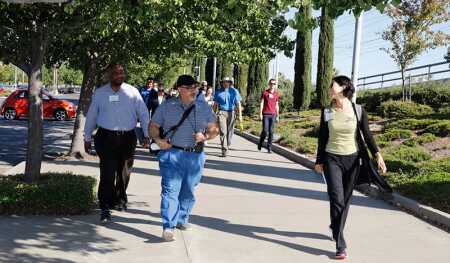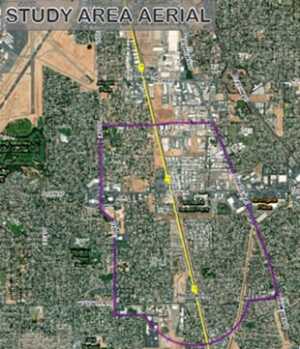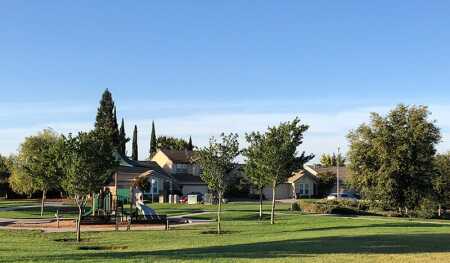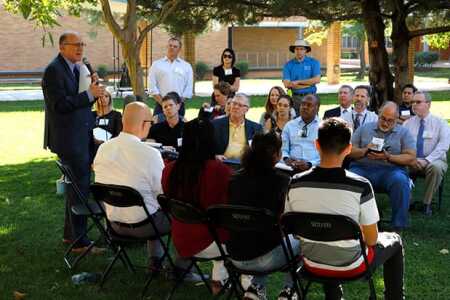A ULI Advisory Services panel toured South Sacramento, California, in September, meeting with more than 75 city and county officials, local business leaders, residents, and other stakeholders. Panelists were tasked with studying the area near two light-rail stations and offering strategies for equitable transit-oriented development (TOD) that could leverage existing community assets and infrastructure to improve physical, social, and economic conditions.
“The light-rail stations are well designed and poised for TOD expansion,” said panel chair David Leininger, former Dallas Area Rapid Transit executive vice president and chief financial officer, during the panel’s final presentation. Leininger said that developing adjacent public land “could spur additional ridership,” and that the market should support development of assets—“upwards of $300 million of new investment,” based on the panel’s preliminary development program for the two station areas.
The four sponsors—Sacramento Regional Transit (SacRT), Sacramento Council of Governments (SACOG), Sacramento Municipal Utility District, and Sacramento Metropolitan Air Quality Management District—asked the ULI advisory panel to outline a plan for kick-starting a retrofit of the two transit-adjacent neighborhoods into transit-oriented neighborhoods. Their goals were to promote equitable, healthy, and inclusive community development that fosters job and income growth, housing options, and healthy neighborhood amenities with more convenient access to transit, retail, and services.
The sponsors also wanted to reduce greenhouse gas emissions, improve air quality, and increase transit ridership. They cited the need for more housing—with an influx of residents from coastal cities like San Francisco—and a future need for 1,700 new homes in the study area projected by the city’s 2035 General Plan. The panel was also done in conjunction with the 10-Minute Walk Campaign—a national initiative by ULI, the National Recreation and Park Association, and the Trust for Public Land—to promote the idea that everyone in urban areas across the United States should have a high-quality park within a 10-minute walk.
Their questions for the panel were as follows: How can parks, open spaces, and active connections to transit be part of local infrastructure and community development plans? How should Sacramento reinvigorate existing infrastructure (physical, social, and economic) to grow an equitable, transit-oriented community around these light-rail stations? Which efforts should the public and private sectors partner on to accomplish early, mid-, and long-term changes? With increasing home costs, how could the cost of new housing be balanced with the need for affordable housing? To address these questions, ULI convened a panel including some of the nation’s best minds in TOD, economic development, social equity, parks and open space, affordable housing, landscape architecture, and finance.
The four-square-mile (10 sq km) study area, located about eight miles (13 km) south of Sacramento’s central business district, centers on the 20-acre (8 ha) Florin Road and 15-acre (6 ha) Meadowview Road light-rail stations, opened 15 years ago as the next-to-last and final stops on the Blue line. In 2016, SacRT extended the Blue line to newer suburban development further south. Now at midpoint, the stations have large, mostly empty commuter parking lots and need improvements for safety and comfort. They are located on busy auto-oriented commercial corridors with businesses like fast-food restaurants and nail salons. Florin Road was “auto-dealership row” until the dealerships headed south. The area also has land uses such as light industrial and offices for public agencies. But decades of disinvestment have left many vacant buildings and lots. The largest concentrations of undeveloped or underdeveloped land sit adjacent to the stations and are owned by SacRT, which is interested in selling or joint-use development of the land.
The challenges of low housing density and lack of connections to jobs, however, have led to the stations’ status of the lowest ridership in Sacramento’s transportation system. Over half the homes in the study area are 1960s- to 1980s-era suburban single-family—the rest are multifamily and mobile homes. The study area’s population of 19,400 has increased by 2,000 residents since 2010, with over 41 percent of households having four or more members. Some 44 percent of residents are under age 25; 30 percent of adults have only a high school degree or equivalent. Unemployment of 11.4 percent is several times greater than the city’s 3.5 percent. Half of all households earn less than $35,000 annually from service or low-level white-collar jobs. Fewer than one-third of households own vehicles in an area with little connecting bus service. While the city’s crime statistics show that the area is relatively safe, it suffers from perceptions that it is not safe. The recent shooting death in the Meadowview neighborhood of Stephon Clark, an unarmed black man, by Sacramento police has heightened community distrust and anger.
The use of a racial-equity lens for equitable development was “a perfect approach to use in these neighborhoods because of the diversity of residents,” said Karen Abrams, program officer for equitable development for the Heinz Endowments in Pittsburgh. The study area includes Latino, Asian, black, and white residents. South Sacramento exhibits a strong sense of pride and identity in its racial and ethnic diversity, a cultural mix reflected in local restaurants, stores, and community centers. But Abrams and other panelists noted that residents also felt neglected, disconnected from government systems, and suspicious of multiple planning efforts that had been done “to the community and not with the community.” Residents also expressed fear of displacement, which is happening elsewhere in the city as housing pressures mount.
“This work is difficult,” and requires time, patience, and commitment, said Abrams. Sacramento leaders need to make sure “that people feel they can be successful in their neighborhoods, and not seek what they want and need by moving out.”
Emphasizing public/private leadership, thoughtful land use, and retrofits to create more multimodal options and green infrastructure, the panel offered some ambitious but achievable recommendations:
- Identify and strengthen leadership within the South Sacramento community. The panel advised cultivating leaders within neighborhood associations, business districts, and nonprofit organizations and a structure to improve collaboration between the community and government agencies.
- Identify an “executive sponsor” for a South Sacramento program to develop safe, connected, active, and green pedestrian and bike transit access to improve “first- and last-mile” options. The neighborhoods need infrastructure fixes to make safer and more comfortable sidewalks, streets, and crossings. The panel advised concepts like “complete streets” with protected sidewalks and bike lanes, road diets, traffic-calming measures, and shade trees and greenway trails, as well as bike parking and repair shops. They said that families need “safe routes to school” plans and free or reduced bus and rail passes.
- Establish a South Sacramento TOD working group with representatives from the city, SacRT, SACOG, Sacramento Housing and Redevelopment Agency (SHRA), and volunteer real estate advisers identified by ULI Sacramento ULI to facilitate planning, design, and development on available SacRT land next to the two light-rail stations.
- Build denser mixed-income and mixed-use multifamily housing to provide affordable units, draw people with higher incomes, and stimulate redevelopment along the corridor. The sites are zoned for higher densities, and the panel recommended the development of 920 units of multifamily housing at the Florin station under a long-term land lease. Ground-floor uses could support the neighborhood with a daycare and a sit-down restaurant or bike shop. At Meadowview, the panel advised that 540 senior units with retail space be created. They recommended drawing on the resources and expertise of SHRA, as well as funding through low-income housing tax credits, New Markets Tax Credits, Opportunity Zones, HUD grants and loans, and TOD incentives.
- Jump-start jobs and entrepreneurship with redevelopment and placemaking of available retail space.
The panel said that the repurposing of underused retail space could provide temporary construction jobs and permanent operating jobs in California’s nascent cannabis industry and other businesses. They advised working with trade unions, the community college, and the Urban League to offer job training and skills programs targeted to the area’s large population of unemployed or underemployed youth.
- Create parks and recreation facilities, community gathering spaces, and healthy food opportunities through station area design, development, and programming. The panel recommended three acres (1.2 ha) of new parks, plazas, and open space for each station area, as well as urban agriculture and community gardens, community kitchens that could provide business opportunities and cooking classes, and a fresh-food market at Florin.
- Use arts and culture to activate station area development and enhance the study area’s sense of place and community. The panel advised programming new parks and gathering spaces for art, entertainment, and festivals, and organizing art projects as a creative outlet for good mental health and for youth leadership development.
“From a real estate and asset standpoint, you’ve got an alignment already in place with light-rail stations two miles apart,” said Leroy Moore, senior vice president and chief operations officer, Tampa Housing Authority. He said that local leaders should seek development around the stations that would create “a more whole community.” The availability of undeveloped land next to the stations and the expertise and resources of SHRA, he said, offered “an incredible wealth of opportunity” to fill a huge demand for affordable and market-rate housing with other neighborhood-serving development.
“You’re already incredibly well served on transit,” said Leininger. “The availability of public lands for development, strong public-sector partners, and a thriving locally based business and retail sector means that development should come. It’s a matter of knowing that it’s going to come, eliminating barriers impeding development, and getting ready to take advantage of it.”
Commenting upon the very limited examples of TOD in the 52-station SacRT system, the panel said that its program for the South Sacramento stations could provide a template to stimulate much more TOD activity throughout the region.








